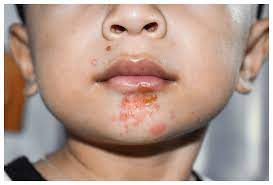
 Superficial skin infection with honeycrusting of skin and caused by S pyogenes or S aureus.
Superficial skin infection with honeycrusting of skin and caused by S pyogenes or S aureus.
Highly infectious highly infectious process with two forms bullous and non-bollus impetigo.
Both Streptococcus pyogenes and Staphylococcal aureus may be present at the same time in the affected skin.
The process may be preceded by a primary infection with MRSA.
Staphylococcal aureus is the most prevalent pathogen in developed countries while Streptococcal pyogenes is more common and developing countries.
Impetigo can be classified into bullous and nonbullous forms.
Nonbullous impetigo is the most common form, representing approximately 70% of diagnosed cases.
Staphylococcal aureus causes nonbullous impetigo in about 70% of cases.
The second most common cause for nonbullous impetigo is group A beta hemolytic streptococci.
Staphylococcus aureus is almost always responsible for bullous impetigo.
Approximately 80% of staphylococcal aureus bacteria are from phage group 2 which can produce exfoliative toxins specific for desmoglein 1(Bangert S et al).
Bulla formation is a result of hydrolysis of extracellular domains of desmoglein 1 by staphylococcal exfoliative toxins resulting in cleavage within the stratum granulosum.
May be a primary process of intact skin or it may occur as a secondary infection of previously infected skin or traumatized skin.
Rarely progresses to a systemic process.
The infectious agent passes from hand contact through broken skin involved by a cutaneous disease process.
Transmission to other individuals is mainly by direct contact and to oneself by auto inoculation.
Can be spread by fomites.
Bulbous impetigo is less contagious than nonbullous impetigo.
A wide variety of conditions may be associated with impetigo and include atopic dermatitis, herpes simplex infection, scabies, varicella, surgery, trauma, thermal burns, insect bites, radiation damage, immunosuppressive agents, HIV infection, diabetes, drug abuse, and dialysis.
Predisposing clinical factors include the presence of poor hygiene, crowded living conditions and skin trauma with abrasions.
In children associated with nasal Staphylococcus aureus colonization.
Accounts for approximately 10% of all skin problems in children, and is the most common bacterial skin infection.
Annual incidence estimated to be 2.8% in children up to four years of age and 1.6% in those aged 5 to 15 years.
After the age of 15 the incidence rapidly declines.
Bullous impetigo occurs primarily in newborns and infants.
Most common in hot humid climates and during summer months in temperate areas.
Non-bullous impetigo occurs most frequently in children aged 2-5 years.
Antibiotics are effective against impetigo.
Topical antibiotics are the preferred treatment if a small area is involved.
Options include mupirocin cream or ointment (Bactroban) and retapamulin ointment (Altabax).
If impetigo is severe or widespread, oral antibotics are prescribed.
Oral antibiotics such as amoxicillin/clavulanate (Augmentin), certain cephalosporins, or clindamycin (Cleocin) can be used.
Oral drugs may work more quickly than topical antibiotics, but they aren’t necessarily better at clearing the infection.
With treatment, impetigo usually heals in 7 to 10 days.
